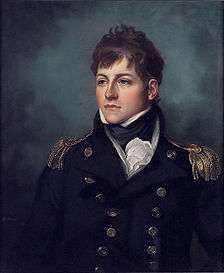George Miller Bligh
| George Miller Bligh | |
|---|---|
 George Miller Bligh in 1808, painted by Mather Brown | |
| Born | 1780 |
| Died |
1834 Southampton, Hampshire |
| Allegiance |
United Kingdom of Great Britain and Ireland |
| Service/branch | Royal Navy |
| Years of service | 1794 – 1834 |
| Rank | Captain |
| Commands held |
HMS Pylades HMS Glatton HMS Acorn HMS Araxes |
| Battles/wars |
Napoleonic Wars *Battle of Trafalgar |
| Relations | Richard Rodney Bligh (father) |
Captain George Miller Bligh (1780–1834) was an officer of the Royal Navy, who saw service during the French Revolutionary and Napoleonic Wars, eventually rising to the rank of Captain. He was present aboard HMS Victory at the Battle of Trafalgar, and was badly wounded during the action. He was taken below and was present in the cockpit during the death of Vice-Admiral Horatio Nelson.
Family and early life
Bligh was born in 1780, the only son of Richard Rodney Bligh, who was later to become an Admiral, and his first wife Ann Worsley.[1] The younger Bligh followed his father into the navy, joining his father's ship HMS Alexander as a midshipman in 1794.[2] Shortly after this the Alexander was captured by a French squadron in an action on 6 November 1794. Bligh became a prisoner of war at Brest, spending six months there until he was able to escape and return to England.[2] He went on to serve aboard a number of ships, including HMS Brunswick, HMS Agincourt, HMS Quebec and HMS Endymion.[2] He was promoted to lieutenant while serving aboard the Endymion in 1801.[3] He returned to serving aboard the Brunswick after this, before being transferred aboard Nelson's flagship HMS Victory in 1804.[3]
Trafalgar

Bligh was present at Trafalgar as commander of Victory's forecastle, where he was wounded in the head and hit by a musket ball in the breast, becoming one of the high proportion of officers to be killed or wounded in the battle.[3][4] Victory's signal Lieutenant John Pasco was also wounded in the battle, while Lieutenant William Ram was killed.[3] Bligh was carried below to be seen by the surgeon William Beatty. He was in the cockpit during the last hours of the mortally wounded Nelson's life, and was depicted in Arthur William Devis's painting The Death of Nelson, 21 October 1805.[5][6] Bligh is depicted apparently dazed from a head wound, and with his left hand over the wound in his side.[7] Bligh survived the battle and recovered in time to be present at Nelson's funeral. He was in a mourning coach on the morning of 8 January, along with Captain Henry William Bayntun, who had commanded HMS Leviathan at Trafalgar, and Captain Thomas Hardy, of the Victory, as well as fellow Victory lieutenant Andrew King.[8] Bligh was promoted to commander on 25 January 1806, in the rewards bestowed to those who had fought at Trafalgar.[3] He was appointed to command the sloop HMS Pylades and despatched to escort a convoy from Falmouth to the Mediterranean.[3]
Command
Bligh remained in command of the Pylades for the next three years, distinguishing his time aboard her with the capture of the French privateer Grand Napoleon on 2 May 1808. He was promoted to post-captain on 27 December 1809 and by early 1810 he was aboard HMS Glatton, escorting a convoy back to England from Malta.[3] He was then appointed to the 18-gun sloop HMS Acorn, which was part of the British squadron protecting their base on the island of Lissa. When three suspicious sails were sighted early in the morning of 28 November, the British squadron put to sea, leaving Bligh in the Acorn, in charge of the station while the rest of the squadron fought an action the next day that resulted in a British victory.[9] Bligh was appointed to the frigate HMS Araxes in 1814, and sailed her to serve on the Jamaica station. He returned to Britain in July 1816, where the Araxes was paid off and Bligh went ashore.[3] He does not appear to have been actively employed again at sea.
Personal life
Bligh married Catherine Haynes on 2 December 1817. He died at Southampton in 1834 and was buried at Alverstoke.[3]
Notes
- ↑ Tracy. Who's who in Nelson's Navy. p. 44.
- 1 2 3 The Gentleman's Magazine. p. 322.
- 1 2 3 4 5 6 7 8 9 The Gentleman's Magazine. p. 323.
- ↑ Adkin. The Trafalgar Companion. p. 120.
- ↑ "Captain George Miller Bligh, circa 1780-1834". National Maritime Museum. Retrieved 14 January 2009.
- ↑ "The Death of Nelson, 21 October 1805". National Maritime Museum. Retrieved 14 January 2009.
- ↑ "Death of Lord Nelson, Trafalgar Octr 21 1805". National Maritime Museum. Retrieved 14 January 2009.
- ↑ The dispatches and letters of vice admiral Nelson: Appendix I. p. 410.
- ↑ James; Charmier. The naval history of Great Britain. pp. 375–6.
References
- Adkin, Mark (2007). The Trafalgar Companion: A Guide to History's Most Famous Sea Battle and the Life of Admiral Lord Nelson. London: Aurum Press. ISBN 1-84513-018-9.
- "Obituaries: Capt. Bligh R.N.". The Gentleman's Magazine. 158. F. Jefferies. 1835.
- James, William (1859). The naval history of Great Britain, from 1793, to 1820, with an account of the origin and increase of the British navy.
- James, William; Charmier, Frederick (1837). The Naval History of Great Britain: From the Declaration of War by France in 1793 to the Accession of George IV. 5. R. Bentley.
- Nicholas, Nicholas Harris, ed. (1846). The dispatches and letters of vice admiral Nelson, with notes by sir N.H. Nicolas: Appendix I.
- Tracy, Nicholas (2006). Who's who in Nelson's Navy: 200 Naval Heroes. London: Chatham Publishing. ISBN 1-86176-244-5.
- "Death of Lord Nelson, Trafalgar Octr 21 1805". National Maritime Museum. Retrieved 14 January 2009.
- "Captain George Miller Bligh, circa 1780-1834". National Maritime Museum. Retrieved 14 January 2009.